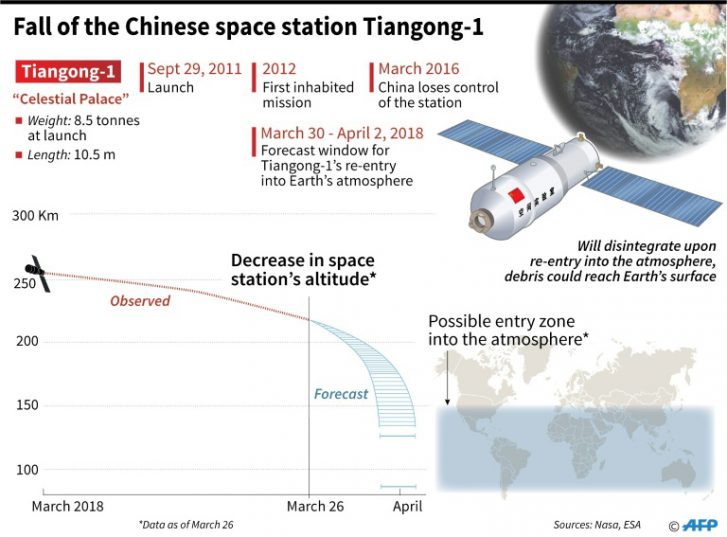Lusikisiki massacre: State withdraws charges against two men
“It will mostly burn up due to the extreme heat generated by its high-speed passage through the atmosphere,” it said in a statement.
Some debris from the Tiangong-1 — or “Heavenly Palace” — spacelab will likely fall into the ocean or somewhere on land, but the chances of human injury are vanishingly small, said Stijn Lemmens, an ESA space debris expert based in Darmstadt, Germany.
“Over the past 60 years of space flight, we are nearing the mark of 6,000 uncontrolled reentries of large objects, mostly satellites and upper (rocket) stages,” he told AFP.
More than 90 percent of those bits of high-tech space junk weighed 100 kilos (220 pounds) or more.
“Only one event actually produced a fragment which hit a person, and it did not result in injury.”
Lemmens calculated the odds of being struck by space debris at one in 1.2 trillion — 10 million times less likely than getting hit by lightning.
The China Manned Space programme, which put Tiangong-1 into orbit in September 2011, has been mostly mum on the fate of China’s first space station, designed to test technologies related to docking in orbit.
Daily updates on its official website have tracked its gradual descent — average altitude as of Tuesday was 207.7 kilometres (129 miles) — but not much else.
On Monday, China’s state-run news agency Xinhua cited the agency as saying the spacelab “should be fully burnt as it reenters the Earth’s atmosphere.”
During its operational lifetime, Tiangong took part in two crewed missions, and an unmanned one.
As with all large satellites and spacecraft, the Chinese spacelab had been slated for a “controlled reentry” that would have seen it fall somewhere in the Pacific Ocean, far from human habitation.
In March 2016, however, the space station ceased functioning.
– ‘Design for demise’ –
With ground teams no longer able to ignite its engines, Tiangong is “expected to make an ‘uncontrolled reentry’,” the ESA said.

Fall of Chinese space station Tiangong-1
“It can be surmised that Tiangong-1 will break up during its atmospheric reentry and that some parts will survive the process and reach the surface of Earth.”
Debris has become a major headache for space agencies and private companies lobbing satellites and other modules into Earth orbit.
The problem is not what comes back down, but what stays in space.
More than 5,000 rockets launched since 1957 have hoisted some 7,500 satellites into orbit, with more than 4,300 of them still in place.
The US Space Surveillance Network tracks some 23,000 debris objects travelling at speeds of up to 28,000 kilometres per hour (17,500 miles per hour).
Statistical models estimate that there are nearly 30,000 objects of at least 10 centimetres across, and 20 times that number measuring between one and 10 cm in diameter.
“These form a real collision risk for spacecraft and manned space-flight activity,” said Lemmens.
“What we really fear is the so-called ‘Kessler Syndrome’, whereby objects collide in an exponential cascade, with one collision causing thousands of fragments that in turn start colliding with others.”
Not much can be done to reduce the volume of orbiting space junk, much of which will eventually drift into Earth’s atmosphere and burn up.
To avoid further clutter, programmed reentry is crucial, said Lemmens. All nations capable of launching a spacecraft have signed a treaty making them liable for damages caused, in space or on Earth, he noted.
Future spacecraft will also be ‘designed for demise’ upon reentry.
A new generation of fuel tanks, for example, will replace ones currently made with titanium, which can withstand very high temperatures.
Tiangong-1 weighed 8.5 tonnes on take off, but with fuel consumption has probably shed at least one tonne.
Download our app